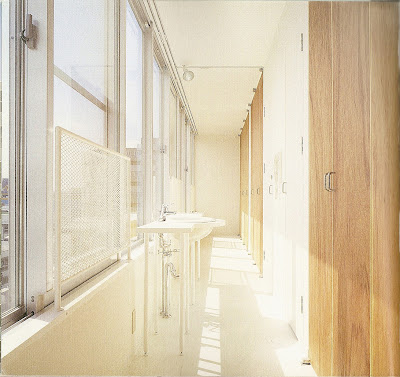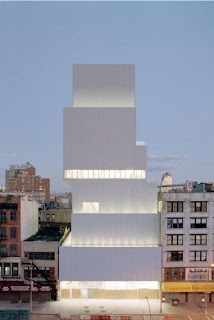FileFront link:
Kevin Cai
2011年10月31日星期一
2011年10月2日星期日
Week 11
Two ideas


The Seattle Central Library redefines the library as an institution no longer exclusively dedicated to the book, but as an information store where all potent forms of media—new and old—are presented equally and legibly. In an age where information can be accessed anywhere, it is the simultaneity of all media and, more importantly, the curatorship of their content that will make the library vital.
The inspiration is that rise several blocks up, let they looks flowing up and high light block's boundray. Show building's interior space and frame structure.
From the street the Lacey can be seen as one large volume set upon a lower volume comprised of duplexes with private entrances, stoops, small front yards (typical of the surrounding row homes). The larger volume holding the various units is actually split in two creating a full-height corridor that runs the length of the site. Each end of the corridor is full-height glass (a light steel frame exterior staircase pushes out from one side that takes residents to a communal terrace and rooftop) allowing for maximum light and ventilation. All access to the units is contained in this central space by means of staggered landings that maximize openness. All of the units have either a balcony, while many have a balcony and either a terrace or courtyard.
The inspiration is that use galss replace holes which fit on the buiding, it work with light can be see a kind of builing transparents. It easy to see interior space and seperat more blocks from building.

Laser cut work with light can be a presentation. technology, not only show building sttucture but also can represent night activity.
TWO poster layouts

 Modular Standardization
Modular Standardization
The use of ‘room’ as a modular building block is not difficult to understand in terms of standardization of major building components in any large scale housing development project. The basic principle of minimizing construction waste at the design level is achieved without doubt... Careful manipulation of spaces results in a variety of internal spatial configurations. Monotonous character has been dissolved and varieties generated while allowing the use of standardized components.
Mass Customization of Spaces
The generated complex spatial configurations and elevations result in more complicated design and construction process. Each floor and each room thus require additional efforts and attentions from the initial design stages to the management of construction works. Although repetitious design of units and buildings has often been argued as a sound practice in terms of efficiency and economy while generating less construction waste, it shall not limit the possibilities of how we design the environment for ourselves the construction possibilities. Mass customization of spaces and building forms in the context of standardization and waste management become a new challenge. New challenges however demand and encourage the industry’s innovation and ability to move forward.

 Site
Site








Refrence:
Gallery MA (2003). Kazuyo Sejima + Ryue Nishizawa / SANAA Works 1995–2003. Toto Shuppan. ISBN 978-4-88706-224-5
GA (2005). Sejima Kazuyo + Nishizawa Ryue Dokuhon. A.D.A. Edita. ISBN 4-87140-662-8
http://gifuprefecture.blogspot.com/


The inspiration is that rise several blocks up, let they looks flowing up and high light block's boundray. Show building's interior space and frame structure.
The Lacey
The inspiration is that use galss replace holes which fit on the buiding, it work with light can be see a kind of builing transparents. It easy to see interior space and seperat more blocks from building.
Laser cut work with light can be a presentation. technology, not only show building sttucture but also can represent night activity.
TWO poster layouts
Gifu Kitagata Apartment Building- Sejima Wing, JAPAN research

 Modular Standardization
Modular StandardizationThe use of ‘room’ as a modular building block is not difficult to understand in terms of standardization of major building components in any large scale housing development project. The basic principle of minimizing construction waste at the design level is achieved without doubt... Careful manipulation of spaces results in a variety of internal spatial configurations. Monotonous character has been dissolved and varieties generated while allowing the use of standardized components.
Mass Customization of Spaces
The generated complex spatial configurations and elevations result in more complicated design and construction process. Each floor and each room thus require additional efforts and attentions from the initial design stages to the management of construction works. Although repetitious design of units and buildings has often been argued as a sound practice in terms of efficiency and economy while generating less construction waste, it shall not limit the possibilities of how we design the environment for ourselves the construction possibilities. Mass customization of spaces and building forms in the context of standardization and waste management become a new challenge. New challenges however demand and encourage the industry’s innovation and ability to move forward.

 Site
Site 


In the project master plan, the courtyard lies between the four separate housing blocks designed byAkiko Takahashi, Kazuyo Sejima, Christine Hawley, and Elizabeth Diller. Because of the diversity of architectural design found within the project, strong site imagery and geometry have been created for the courtyard to unify the distinct parts of the project and to give the project a memorable identity.
Body




All rooms are equally lined up along the side receiving the most sun. These rooms are linked on the front by a narrow sunroom ("engawa"), which constitutes an intermediate space or buffer zone between interior and exterior. The silhouettes of people moving inside are visible on the south facade as on a screen.

These blocks are combined in a variety of ways to produce a multitude of apartment plans and sections, thus generating complex elevations.
Each unit, consisting a few basic blocks, has provided with a courtyard-like terrace. The terraces create holes in the building through which the far side of the building can be glimpsed, thus reducing the visual impression of massiveness.
Refrence:
2011年9月25日星期日
2011年9月23日星期五
2011年9月21日星期三
2011年9月17日星期六
Break work
the new museum of contemporary art
Kazuyo Sejima and ryue nishizawa have been working collaboratively under the name ‘sanaa’ since 1995. Sejima studied architecture at the japan women's university before collaborating with architect toyo ito. She launched her own practice in 1987 and was named ‘young architect of the year’ in japan in 1992. Nishizawa studied architecture at yokohama national university and, in addition to his work with sejima, has also maintained an independent practice since 1997.






Kazuyo Sejima and ryue nishizawa have been working collaboratively under the name ‘sanaa’ since 1995. Sejima studied architecture at the japan women's university before collaborating with architect toyo ito. She launched her own practice in 1987 and was named ‘young architect of the year’ in japan in 1992. Nishizawa studied architecture at yokohama national university and, in addition to his work with sejima, has also maintained an independent practice since 1997.






2011年8月21日星期日
订阅:
博文 (Atom)


















